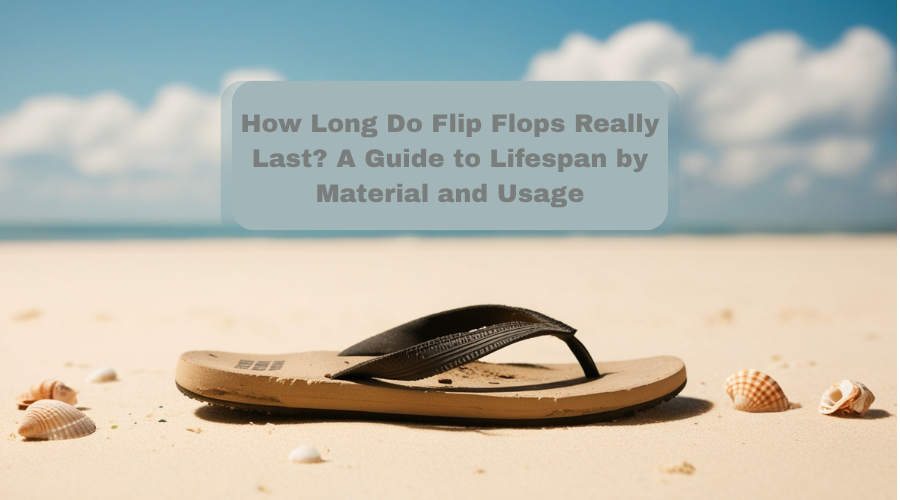-
 sales@fulikaisz.com.cn
sales@fulikaisz.com.cn
-
 13827489472
13827489472
 sales@fulikaisz.com.cn
sales@fulikaisz.com.cn
 13827489472
13827489472

Flip flops are great for the beach, relaxing weekends, hanging out by the pool, or quick errands. But have you ever thought about how long they actually last? That favorite pair might seem like it’ll last forever, but how long they hold up really depends on how often you wear them, what they’re made of, and how well you take care of them.
In this guide, we’ll walk you through everything you need to know about the durability of flip flops, based on materials, usage habits, and care tips. Whether you’re a casual wearer or a flip flop fanatic, this article will help you make smarter choices (and save money in the long run).
It might seem like a minor detail, but wearing worn-out flip flops can lead to more than just frayed straps—it can cause foot pain, blisters, and even posture problems. Just like your running shoes, flip flops lose support over time. So knowing when to replace them (and choosing the right type) can make a real difference for your comfort and health.
Not all flip flops are created equal. Here’s a breakdown of common materials and how long each type tends to last:
• Lifespan: 6–12 months (with moderate use)
• Pros: Lightweight, cushy, and affordable
• Cons: Can flatten quickly, especially with daily wear
Many people like EVA since it feels soft and protects you from shocks, yet it breaks when put under permanent stress. Swimsuits are perfect to have around for times you are at the pool or on vacation.
• Lifespan: 1–3 years
• Pros: Durable, waterproof, long-lasting
• Cons: Heavier than foam
Rubber flip flops are your best bet for durability, especially if you wear them often. They resist moisture, hold their shape, and don’t degrade as quickly. A good-quality rubber pair can last multiple summers with proper care.
• Lifespan: 2–5 years (with proper care)
• Pros: Stylish, long-wearing, molds to your feet
• Cons: Not water-friendly, requires maintenance
Leather flip flops are more of a fashion statement than a beach necessity. With proper conditioning and limited water exposure, they can become your most reliable warm-weather companion.
• Lifespan: 1–2 years
• Pros: Comfortable, breathable
• Cons: Prone to staining, stretching, and tearing
These offer a casual, comfortable fit, but don’t expect them to hold up if you wear them every day. Their fabric straps and footbeds wear down faster, especially in wet or dirty conditions.
Even the sturdiest flip flops will deteriorate fast if you wear them like sneakers. Here’s how usage habits affect longevity:
Flip flops that live in your closet and come out only on sunny weekends can last years, regardless of material. If you're wearing them only a couple times a month, you're in the clear.
Walking in flip flops every day causes stress to both the underside and straps of your feet. At this point, you will want the safety that rubber or leather provide you. You may start feeling that your mattress lacks support after just 3 months.
Saltwater, chlorine, and sand can degrade materials faster, especially leather and fabric. For these situations, opt for rubber or waterproof EVA, and rinse them after use.
Don’t wait for your flip flops to fall apart entirely. Here are some telltale signs they’ve reached their expiration date:
• The sole is flat with no visible arch support
• The tread is worn down, making them slippery
• The straps feel loose or keep popping out
• Cracks or holes in the footbed or sole
• Your feet hurt after wearing them
• Your feet deserve better than worn-out sandals. If any of these signs show up, it’s time to start shopping.
Want to make your favorite pair last longer? Try these simple tips:
• Rotate your pairs: Don’t wear the same pair every day.
• Clean them regularly: A quick wash can prevent material breakdown and bad odors.
• Avoid harsh sun exposure: UV rays can crack and dry out rubber and foam.
• Store them properly: Keep them out of hot cars or damp areas.
• Don’t overuse them: They’re not made for long walks or rough terrain.
Just a little extra care can double the lifespan of your flip flops.
Great question. The answer? Sometimes, yes.
Premium flip flops (like those from brands such as Reef, Teva, or OluKai) use high-quality rubber, leather, or memory foam, and are designed for extended wear. While they may cost more up front, they often outlast cheap options by two to three times.
If you're someone who wears flip flops every day, investing in a supportive, well-made pair could be better for both your feet and your wallet.
So, how long do flip flops really last?
That depends on what they’re made of, how you use them, and how well you take care of them. As a quick reference:
• EVA Foam: 6–12 months
• Rubber: 1–3 years
• Leather: 2–5 years
• Fabric: 1–2 years
The best flip flops depend on how you use them. Heading to the beach? Foam works great. Walking a lot? Go for rubber. Dressing up for brunch? Try leather.
No matter what you choose, remember: flip flops don’t last forever, but with the right material and good care, they can last longer.
Q: Can flip flops be recycled?
A: Some brands offer recycling programs, especially for rubber flip flops. Always check local guidelines or look for companies with take-back policies.
Q: Are flip flops bad for your feet?
A: Not inherently—but wearing flat, unsupportive ones constantly can lead to foot pain or problems. Look for flip flops with arch support for daily wear.
Q: How can I clean my flip flops?
A: Most rubber and EVA flip flops can be soaked in soapy water and scrubbed gently. Avoid soaking leather; use a damp cloth and leather cleaner instead.